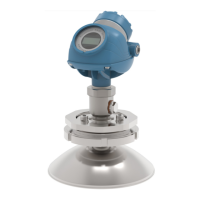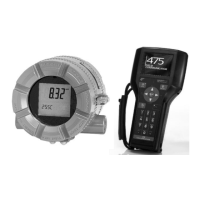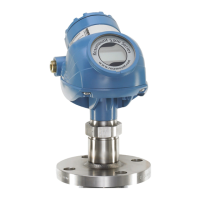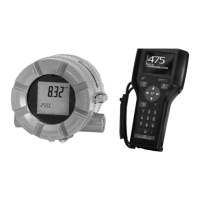199
Reference Manual
00809-0100-4026, Rev KC
Safety Instrumented Systems (4-20 mA Only)
October 2018
Safety Instrumented Systems (4-20 mA Only)
Note
The Rosemount 5400 is not safety-rated during maintenance work, configuration changes, multidrop,
loop test, or other activity that affects the Safety Function. Alternative means should be used to ensure
process safety during such activities.
8.3 Functional specifications
The Safety Function is based on the analog output 4-20 mA, used as the safety variable. It is configured
to activate the alarm function if an error occurs or if the measured value goes beyond the measurement
range set by the user.
In the case of the Rosemount 5400, the definition of the Safe State Safety Function is:
The distance measurement is performed as intended inside the safety accuracy limits, that is with a
deviation of < ±2% of the measuring range.
The safety analog output signal is set outside the normal 4-20 mA range (Low or High Alarm). The
Rosemount standard alarm setting
is: <
3.75 mA or > 21.75 mA.
Only the 4-20 mA output can be used in the Safety Function. The HART
®
protocol can only be used for
setup, calibration, and diagnostic purposes, not for safety critical operation. The measurement signal
used by the logic solver must be the analog 4-20 mA signal proportional to the level generated.
8.4 Installation
The device should be installed and configured as a level sensing device per manufacturer’s instructions.
The materials must be compatible with process conditions and process fluids. No special installation is
required in addition to what is described in this section, the standard installation practices outlined in
Section 3: Mechanical Installation, and the Rosemount 5400 Level Transmitter Quick Start Guide
.
Environmental limits are available in Appendix A: Specifications and Reference Data.
Note
False echoes within the radar beam from obstructions may lead to a situation where the Rosemount
5400 can no longer be used for safety related functions with the listed failure rates, SFF, and PFD
AVG
.
However, reduced proof test intervals can help to detect such unwanted causes.
The loop must be designed so the terminal voltage does not drop below the minimum input voltage, see
values in Ta ble 8 -2, when the transmitter output is 21.75 mA. The input voltage U
i
for HART is 16-42.4
Vdc (16-30 Vdc in IS applications, and 20-42.4 Vdc in Explosion-proof/Flameproof applications).
The HART loop must be referenced to ground in one point located between the power supply and the
load resistor. Either the negative or the positive pole of the power supply can be ground referenced,
depending on the placement of the load resistor. See Figure 8-1 as an example.

